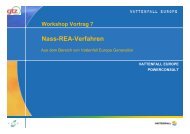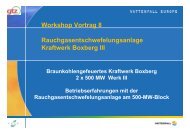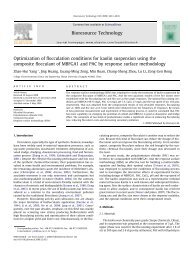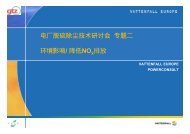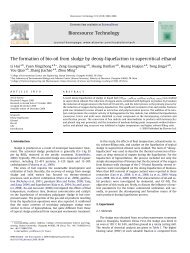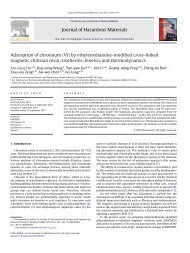Quantitative effects of composting state variables on ... - ResearchGate
Quantitative effects of composting state variables on ... - ResearchGate
Quantitative effects of composting state variables on ... - ResearchGate
Create successful ePaper yourself
Turn your PDF publications into a flip-book with our unique Google optimized e-Paper software.
1252 W. Sun et al. / Science <str<strong>on</strong>g>of</str<strong>on</strong>g> the Total Envir<strong>on</strong>ment 409 (2011) 1243–1254<br />
40<br />
35<br />
30<br />
Experimental<br />
Run1<br />
Run2<br />
Run3<br />
Run4<br />
Run5<br />
Run6<br />
40<br />
35<br />
30<br />
Predicted<br />
Run1<br />
Run2<br />
Run3<br />
Run4<br />
Run5<br />
Run6<br />
25<br />
25<br />
C/N<br />
20<br />
C/N<br />
20<br />
15<br />
15<br />
10<br />
10<br />
5<br />
0 5 10 15 20 25 30 35 40 45<br />
Time (d)<br />
Blank nodes are in Training Set; Solid nodes are in Test Set<br />
5<br />
0 5 10 15 20 25 30 35 40 45<br />
Time (d)<br />
Fig. 8. Dynamic variati<strong>on</strong>s <str<strong>on</strong>g>of</str<strong>on</strong>g> C/N ratios.<br />
implies that the total loss <str<strong>on</strong>g>of</str<strong>on</strong>g> both organic matters and available<br />
mineral c<strong>on</strong>stituents have significant <str<strong>on</strong>g>effects</str<strong>on</strong>g> <strong>on</strong> the C/N ratio<br />
variati<strong>on</strong>.<br />
The NH 4 + -N c<strong>on</strong>centrati<strong>on</strong> keeps a very low increasing tendency<br />
(from 20.86 to 154.41 mg/kg, wet Sample) before Day 21 and rapidly<br />
reaches a peak (828.16 mg/kg, wet Sample) in Day 33, which indicates<br />
a significant biodegradati<strong>on</strong> <str<strong>on</strong>g>of</str<strong>on</strong>g> organic nitrogen c<strong>on</strong>tent (amm<strong>on</strong>ificati<strong>on</strong><br />
process) in the latter stage. It is noted that NH 4 + -N<br />
c<strong>on</strong>centrati<strong>on</strong> is the first important variable affecting the C/N ratio<br />
in the GASCA tree. This implies that the variati<strong>on</strong> <str<strong>on</strong>g>of</str<strong>on</strong>g> NH 4 + -N<br />
c<strong>on</strong>centrati<strong>on</strong> plays a major role in the variati<strong>on</strong> <str<strong>on</strong>g>of</str<strong>on</strong>g> total nitrogen.<br />
NH 3 emissi<strong>on</strong> in the outlet gas fluctuates within a very small range<br />
(between 52.99 and 99.11 μg/day) before Day 29 and increases<br />
rapidly to a peak (5.99 ×10 4 μg/day) in Day 35. The low pH<br />
envir<strong>on</strong>ment in the initial stage (before Day 27) might inhibit the<br />
NH 3 release from amm<strong>on</strong>ium. The NH 3 emissi<strong>on</strong> peak occurs when<br />
the pH reaches the highest level (7.15) in Day 35. The similar<br />
tendencies <str<strong>on</strong>g>of</str<strong>on</strong>g> NH 3 emissi<strong>on</strong> variati<strong>on</strong> and its close relati<strong>on</strong>ships with<br />
compost pH level were observed in other <str<strong>on</strong>g>composting</str<strong>on</strong>g> food wastes<br />
(Lin, 2008).<br />
5. Discussi<strong>on</strong><br />
<str<strong>on</strong>g>Quantitative</str<strong>on</strong>g> analysis <str<strong>on</strong>g>of</str<strong>on</strong>g> complicated interacti<strong>on</strong>s between <str<strong>on</strong>g>state</str<strong>on</strong>g><br />
<str<strong>on</strong>g>variables</str<strong>on</strong>g> and the C/N ratio during food waste <str<strong>on</strong>g>composting</str<strong>on</strong>g> is a<br />
challenge. Most previous studies focused <strong>on</strong> the relati<strong>on</strong>ships<br />
between initial C/N ratios and final compost quality (Larsen and<br />
McCartney, 2000; Eiland et al., 2001; Huang et al., 2004; Kumar et al.,<br />
2010) or the <str<strong>on</strong>g>effects</str<strong>on</strong>g> <str<strong>on</strong>g>of</str<strong>on</strong>g> initial c<strong>on</strong>diti<strong>on</strong>s <strong>on</strong> the final C/N ratios in<br />
compost (Gao et al., 2010). In fact, inherent <str<strong>on</strong>g>composting</str<strong>on</strong>g> mechanisms<br />
exist in dynamic interacti<strong>on</strong>s between <str<strong>on</strong>g>state</str<strong>on</strong>g> <str<strong>on</strong>g>variables</str<strong>on</strong>g> and target<br />
characteristics.<br />
Bacteria (log CFU/g (dry))<br />
15<br />
10<br />
Thermophilic<br />
Mesophilic<br />
5<br />
0 10 20 30 40<br />
Time (d)<br />
Temperature ( o C)<br />
60<br />
50<br />
40<br />
pH<br />
Upper Temp<br />
30<br />
Lower Temp<br />
Mean Temp<br />
20<br />
0 10 20 30 40<br />
Time (d)<br />
Water C<strong>on</strong>tent (%)<br />
80<br />
75<br />
70<br />
65<br />
Organic<br />
Water<br />
40<br />
35<br />
30<br />
25<br />
60<br />
0 10 20 30 40 20<br />
Time (d)<br />
Organic C<strong>on</strong>tent (%)<br />
NH -N (mg/kg,wet)<br />
+<br />
4<br />
1000<br />
800<br />
600<br />
400<br />
200<br />
0<br />
0 10 20 30 40<br />
Time (d)<br />
x 10 4<br />
6<br />
5<br />
4<br />
3<br />
2<br />
1<br />
100<br />
80<br />
60<br />
40<br />
20<br />
0 5 10 15 20 25<br />
0<br />
0 10 20 30 40<br />
Time (d)<br />
pH<br />
7.5<br />
3<br />
7<br />
6.5<br />
Ash<br />
2.5<br />
6<br />
pH<br />
5.5<br />
2<br />
5<br />
4.5<br />
4<br />
3.5<br />
0 10 20 30<br />
1.5<br />
40 1<br />
Time (d)<br />
Ash C<strong>on</strong>tent (%)<br />
Fig. 9. Dynamic variati<strong>on</strong>s <str<strong>on</strong>g>of</str<strong>on</strong>g> <str<strong>on</strong>g>state</str<strong>on</strong>g> <str<strong>on</strong>g>variables</str<strong>on</strong>g> for Run 5.




